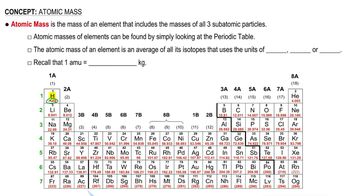What was the mass in atomic mass units of a 40Ca atom prior to 1961 if its mass on today’s scale is 39.9626? (See Problem 2.168.)
 Verified step by step guidance
Verified step by step guidanceKey Concepts
Atomic Mass Unit (amu)

Isotopic Mass and Scale Changes

Mass Spectrometry

In an alternate universe, the smallest negatively charged particle, analogous to our electron, is called a blorvek. To determine the charge on a single blorvek, an experiment like Millikan's with charged oil droplets was carried out, and the following results were recorded : (a) Based on these observations, what is the largest possible value for the charge on a blorvek?
In an alternate universe, the smallest negatively charged particle, analogous to our electron, is called a blorvek. To determine the charge on a single blorvek, an experiment like Millikan's with charged oil droplets was carried out, and the following results were recorded : (b) Further experiments found a droplet with a charge of 5.81 * 10-16 C. Does this new result change your answer to part (a)? If so, what is the new largest value for the blorvek's charge?
